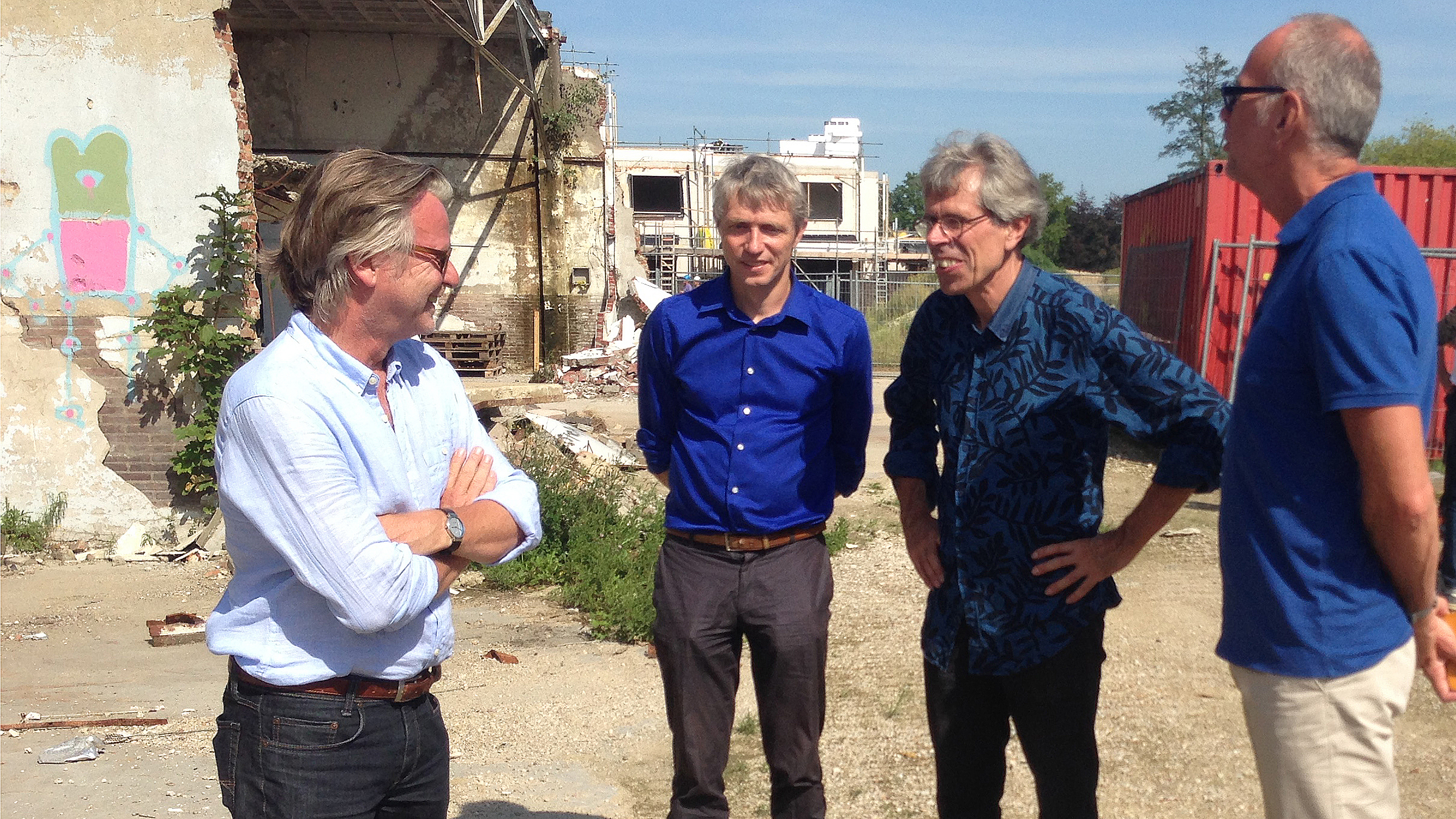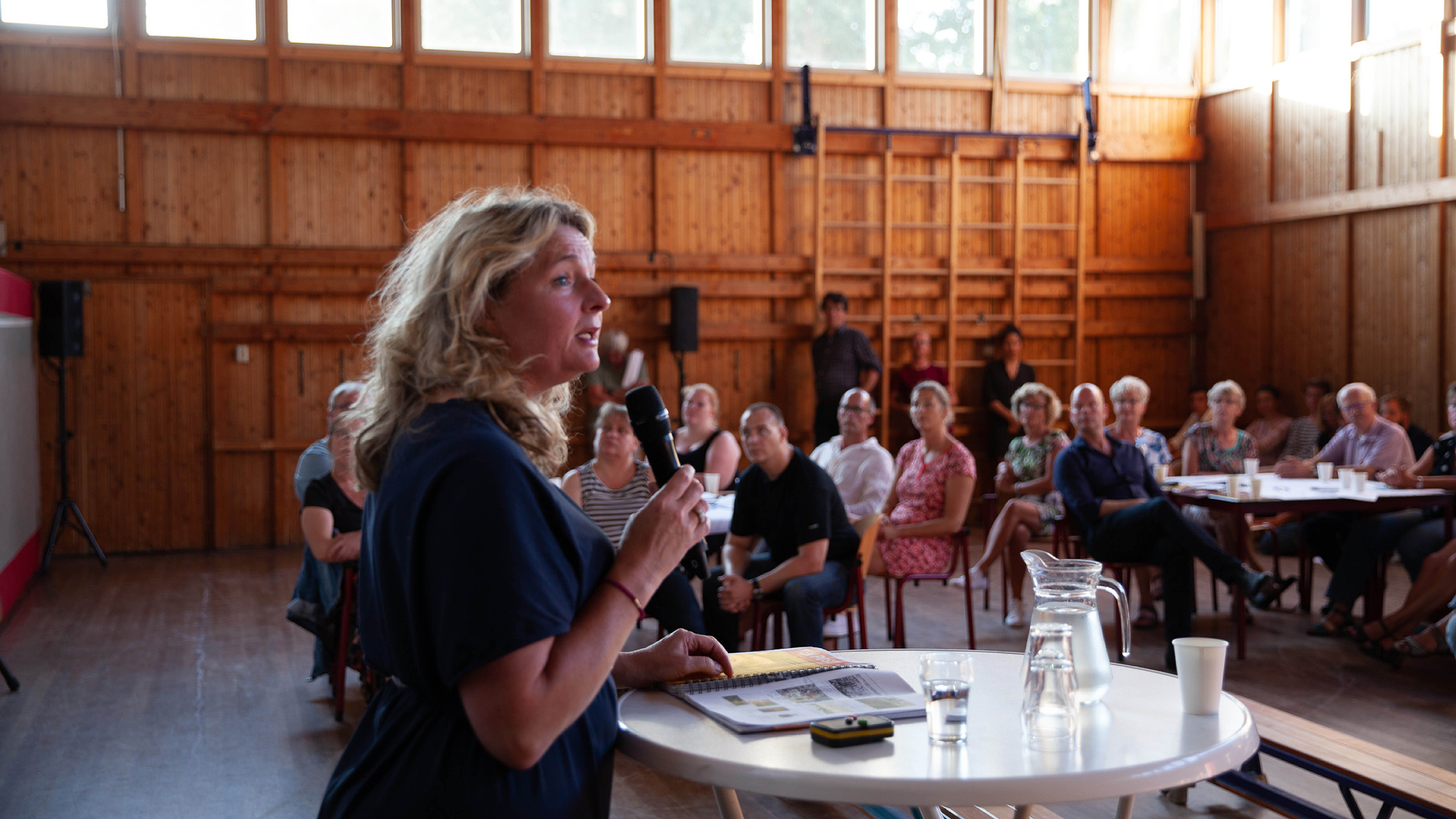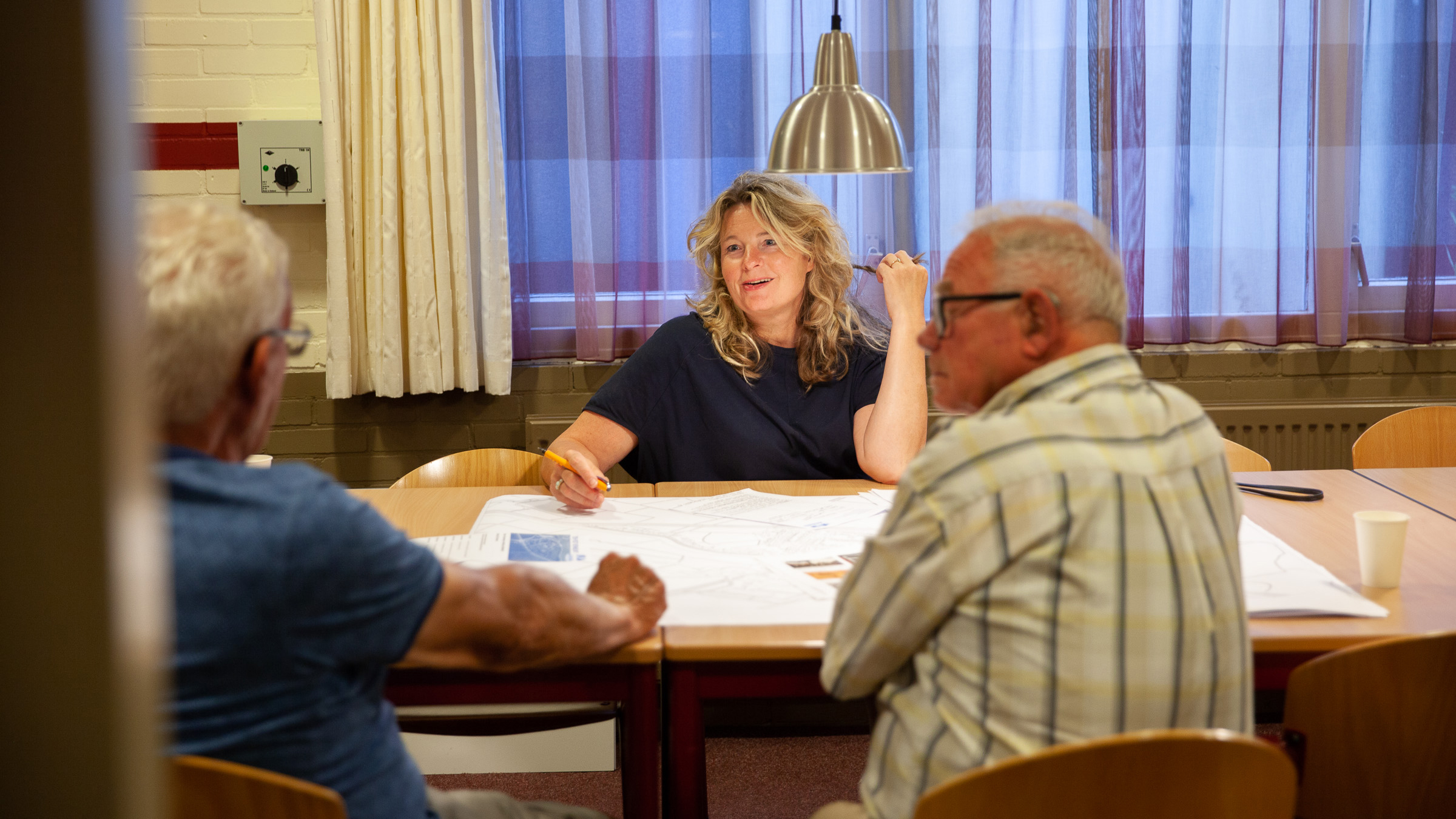




SUPERVISION, MEDIATION AND PARTICIPATION
WHAT DOES STEENHUISMEURS DO?
When faced with extensive spatial assignments, municipalities or project developers often appoint supervisors and quality teams. Because we know how to connect our vision of cultural history with social and commercial goals in an inspired way, we are regularly invited for this purpose. Paul, for example, is an advisor to BOEi (restoration, adaptive reuse and transformation of cultural heritage) and a member of the Quality Team of the Dutch Water Defence Lines (world heritage), Marinke the chairperson of the Waalfront and West Spatial Quality Team in Nijmegen and a member of the Quality Team Afsluitdijk (enclosure dam in the former Zuiderzee), and Vita a member of the Advisory Committee on Environmental Quality of the municipality of Delft. We ensure that cultural heritage and spatial qualities are safeguarded and recognise opportunities for additional incentives in this respect. In doing so, it does not matter which side of the table we are on; what matters to us is content and context. Our active involvement in transformation processes, city labs or the sale of public real estate usually follows from structural visions, and architectural or transformation guidelines drawn up by us. As a member of independent, multidisciplinary think tanks, we advise governing authorities on matters such as building aesthetics, sustainability, user programmes, laws and regulations, and planning instruments. As a mediator we bring parties and spatial functions together in processes where needs and motivations of stakeholders differ. Through the years, we have built up an extensive network in the world of real estate, design and heritage.
LOOKING BACK ON THE IMPROVEMENT PROGRAM OF THE GARDEN CITY OF VREEWIJK ROTTERDAM
Commissioned by: the tenants' association housing corporation Havensteder and the municipality of Rotterdam
SteenhuisMeurs collaborated with conflict resolution specialist Lenka Hora Adema to draw lessons from the neighbourhood renewal programme in the garden city of Vreewijk. The Improvement Program commenced in 2012 and concluded in 2023. Over the span of eleven years, 1300 homes in Vreewijk underwent renovation. In this, Havensteder, the municipality, and the tenants' association of Vreewijk (BOV) collaborated closely. The process was marked by both pride and turbulence, with protests against demolition and even interventions from ministers who visited the garden city.
Vreewijk is a nationally protected urban area. As such, the neighbourhood received some financial support from the national government for renovation efforts in which the unique aspect of Vreewijk could be conserved: the combination of comfortable homes and surrounding green spaces. We focused on uncovering the cycles and parallels in Vreewijk's 109-year history, and how we could learn from past events. Just as in one's own family, old patterns can persist across generations for a long time. Insight into the perceptions of the renovation process among the different parties provided ground for reconciliation. Gradually, a shared set of principles, expectations and agreements for the future emerged. In August 2023, there was a partner event in Vreewijk, where we commemorated the positive shift and the change in behaviour that was instigated by this project.

TOPICUS SITE, DEVENTER
Quality Team
Directly opposite the train station of Deventer, several buildings are owned by the IT company Topicus. The company owns almost the entire city block, located within the protected cityscape. The owner aims to transform the block into a dynamic and attractive 'Topicus Campus' with offices, facilities, and residences. The campus should contribute to an appealing living and working environment, helping to attract professionals to Deventer. The initial designs for the location sparked controversy in the city due to the proposed scale and building height. In response, the municipality commissioned SteenhuisMeurs to conduct a cultural heritage assessment. Subsequently, a Quality Team was appointed, consisting of architect Bert Dirrix, landscape architect Philomene van Vliet and Paul Meurs of SteenhuisMeurs. The Quality Team translated the heritage assessment into spatial principles and criteria for evaluation, and has since been guiding the development of the master plan.

ORGANISATIONAL ADVICE ANDS AUDITS
There is a growing demand for SteenhuisMeurs’ audits: systemic analyses in which the reflection on a (civil) organisation or foundation is linked to the characteristics and the Umfeld of the city in which the organisation is active. Is there a reason to change course? And if so, what will work? For the Van der Leeuwkring in Rotterdam, Marinke reflected on the significance of the foundation in the changing urban climate, for the Urban Development department of Almere she made De geleefde stad (The lived city): the characteristics of Almere (2020), in which the experiences, lifestyles and ideas of the residents of Almere were collected in 15 citizen tables. In The Hague she analysed the course of Stichting Wonen in The Hague (2021), a foundation in which developers, investors and brokers are united. The results are presented in a lecture or a film, and provide the client with new energy for the discussion on the new course, based on the individual character of city and organisation.

PAUL MEURS
– Member Quality Team World Heritage Site Dutch Water Defence Lines, on behalf of the site holder
– Member Quality Team Topicus, on behalf of the municipality of Deventer
– Member Quality Team redevelopment De Kaai, Rotterdam
– Member BOEi Investment Committee, National Society for the Restoration and Adaptive Reuse of Cultural Heritage (Nationale Maatschappij tot Restaureren en Herbestemmen van Cultureel Erfgoed), Amersfoort
– Supervisor redevelopment Oude Kooi, Zeeheldenbuurt and Tuinstadwijk in Leiden, together with urban planner Martin Verwoest

MARINKE STEENHUIS
– Member of Quality Team Water Authority Rhine and IJssel
– Member Quality Team Artis Amsterdam
– Member of the independent advisory council development Waterloopbos
– Co-developer and lecturer course Gebiedsontwerp at the Academy of Architecture, Groningen

VITA TEUNISSEN
– Member Advisory Committee on Environmental Quality (building aesthetics) municipality of Delft
– Member Quality Team Afsluitdijk, on behalf of Rijkswaterstaat






SUPERVISION, MEDIATION AND PARTICIPATION
WHAT DOES STEENHUISMEURS DO?
When faced with extensive spatial assignments, municipalities or project developers often appoint supervisors and quality teams. Because we know how to connect our vision of cultural history with social and commercial goals in an inspired way, we are regularly invited for this purpose. Paul, for example, is an advisor to BOEi (restoration, adaptive reuse and transformation of cultural heritage) and a member of the Quality Team of the Dutch Water Defence Lines (world heritage), Marinke the chairperson of the Waalfront and West Spatial Quality Team in Nijmegen and a member of the Quality Team Afsluitdijk (enclosure dam in the former Zuiderzee), and Vita a member of the Advisory Committee on Environmental Quality of the municipality of Delft. We ensure that cultural heritage and spatial qualities are safeguarded and recognise opportunities for additional incentives in this respect. In doing so, it does not matter which side of the table we are on; what matters to us is content and context. Our active involvement in transformation processes, city labs or the sale of public real estate usually follows from structural visions, and architectural or transformation guidelines drawn up by us. As a member of independent, multidisciplinary think tanks, we advise governing authorities on matters such as building aesthetics, sustainability, user programmes, laws and regulations, and planning instruments. As a mediator we bring parties and spatial functions together in processes where needs and motivations of stakeholders differ. Through the years, we have built up an extensive network in the world of real estate, design and heritage.
LOOKING BACK ON THE IMPROVEMENT PROGRAM OF THE GARDEN CITY OF VREEWIJK ROTTERDAM
Commissioned by: the tenants' association housing corporation Havensteder and the municipality of Rotterdam
SteenhuisMeurs collaborated with conflict resolution specialist Lenka Hora Adema to draw lessons from the neighbourhood renewal programme in the garden city of Vreewijk. The Improvement Program commenced in 2012 and concluded in 2023. Over the span of eleven years, 1300 homes in Vreewijk underwent renovation. In this, Havensteder, the municipality, and the tenants' association of Vreewijk (BOV) collaborated closely. The process was marked by both pride and turbulence, with protests against demolition and even interventions from ministers who visited the garden city.
Vreewijk is a nationally protected urban area. As such, the neighbourhood received some financial support from the national government for renovation efforts in which the unique aspect of Vreewijk could be conserved: the combination of comfortable homes and surrounding green spaces. We focused on uncovering the cycles and parallels in Vreewijk's 109-year history, and how we could learn from past events. Just as in one's own family, old patterns can persist across generations for a long time. Insight into the perceptions of the renovation process among the different parties provided ground for reconciliation. Gradually, a shared set of principles, expectations and agreements for the future emerged. In August 2023, there was a partner event in Vreewijk, where we commemorated the positive shift and the change in behaviour that was instigated by this project.

TOPICUS SITE, DEVENTER
Quality Team
Directly opposite the train station of Deventer, several buildings are owned by the IT company Topicus. The company owns almost the entire city block, located within the protected cityscape. The owner aims to transform the block into a dynamic and attractive 'Topicus Campus' with offices, facilities, and residences. The campus should contribute to an appealing living and working environment, helping to attract professionals to Deventer. The initial designs for the location sparked controversy in the city due to the proposed scale and building height. In response, the municipality commissioned SteenhuisMeurs to conduct a cultural heritage assessment. Subsequently, a Quality Team was appointed, consisting of architect Bert Dirrix, landscape architect Philomene van Vliet and Paul Meurs of SteenhuisMeurs. The Quality Team translated the heritage assessment into spatial principles and criteria for evaluation, and has since been guiding the development of the master plan.

ORGANISATIONAL ADVICE ANDS AUDITS
There is a growing demand for SteenhuisMeurs’ audits: systemic analyses in which the reflection on a (civil) organisation or foundation is linked to the characteristics and the Umfeld of the city in which the organisation is active. Is there a reason to change course? And if so, what will work? For the Van der Leeuwkring in Rotterdam, Marinke reflected on the significance of the foundation in the changing urban climate, for the Urban Development department of Almere she made De geleefde stad (The lived city): the characteristics of Almere (2020), in which the experiences, lifestyles and ideas of the residents of Almere were collected in 15 citizen tables. In The Hague she analysed the course of Stichting Wonen in The Hague (2021), a foundation in which developers, investors and brokers are united. The results are presented in a lecture or a film, and provide the client with new energy for the discussion on the new course, based on the individual character of city and organisation.

PAUL MEURS
– Member Quality Team World Heritage Site Dutch Water Defence Lines, on behalf of the site holder
– Member Quality Team Topicus, on behalf of the municipality of Deventer
– Member Quality Team redevelopment De Kaai, Rotterdam
– Member BOEi Investment Committee, National Society for the Restoration and Adaptive Reuse of Cultural Heritage (Nationale Maatschappij tot Restaureren en Herbestemmen van Cultureel Erfgoed), Amersfoort
– Supervisor redevelopment Oude Kooi, Zeeheldenbuurt and Tuinstadwijk in Leiden, together with urban planner Martin Verwoest

MARINKE STEENHUIS
– Member of Quality Team Water Authority Rhine and IJssel
– Member Quality Team Artis Amsterdam
– Member of the independent advisory council development Waterloopbos
– Co-developer and lecturer course Gebiedsontwerp at the Academy of Architecture, Groningen

VITA TEUNISSEN
– Member Advisory Committee on Environmental Quality (building aesthetics) municipality of Delft
– Member Quality Team Afsluitdijk, on behalf of Rijkswaterstaat


